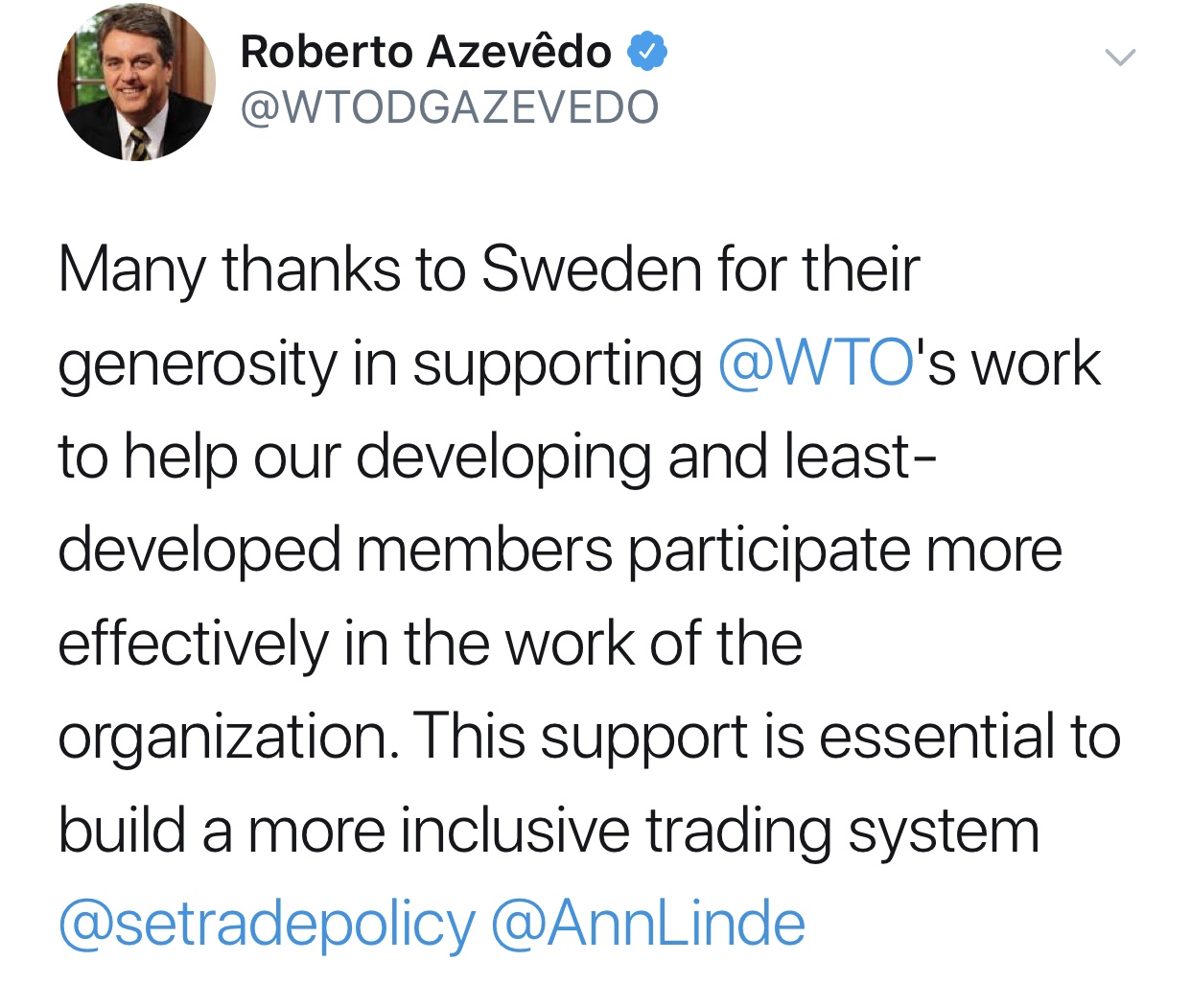Roberto Azevedo: Many thanks to Sweden for their generosity in supporting WTO’s work to help our developing and least-developed members participate more effectively in the work of the organization.


“This support is essential to build a more inclusive trading system”.
…vacation. Some days off.

I am off for a few days of summer holiday with the family to reload batteries and enjoy new books, the sun and a glass of rose’ wine…
My colleague and friend Jonas Lind, CEO at Silverlake Symmetri asks the excellent question “Why are we not already at B?” in an insighful LinkedIn article. He is absolutely right.

This is the text:
How to unfreeze digital transformation in the Public Sector
The age of digital is imminent and embracing the digital revolution is inevitable. At least that’s what the man on the street believes. And this wave is prompting governments to analyse both their digital strategy and ability to accept and adapt to this phenomenon.
But for all the good intentions, why then are Governments stuck with the unfortunate image of being unable to change. That transformation in the Public Sector is either impossible or even if attempted, often ends in failure?
Of course, this is not always true. But wasn’t your first gut instinct to agree with me? As the saying goes, there’s no smoke without fire.
What has ‘Unfreezing’ and Force Field Analysis got to do with digital transformation?
Before delving into public sector digital transformation, we first need to understand change. A simple model that I find useful is the 3-step Unfreeze – Change –Freeze (Refreeze) model developed by the German-American psychologist Kurt Lewin. His change model can be summed up in the diagram below.
Of these, the most difficult is the first stage of unfreezing. It is difficult because it involves overcoming inertia and moving away from our comfort zone. But ‘unfreezing’ is also the most important because without it, change and transformation will never happen.
The next logical question then is “What do we ‘unfreeze’?” In order to figure out what to unfreeze, we need to do some analysis, and this is where Lewin’s Force Field Analysis comes in. The idea behind Lewin’s force field analysis is that there are basically two types of forces working for (driving forces) and against (restraining forces) change.
Based on these two concepts, we can now apply it to our context of a government digital transformation.
For example, when embarking on any transformation initiative, governments can first use Force Field Analysis to assess the potential of success in its transformation journey. The diagram below is an example of how Force Field Analysis can be applied to see whether digital transformation for a government can actually happen (Note: The length of the arrows typically represents the strength of the force).
If the driving forces are greater than restraining forces, then digital transformation occurs. If it’s vice versa, then nothing happens.
“My organisation still isn’t transforming!”
Now, having all this analysis at our fingertips is all well and good. But I’m sure you must still be thinking that it tells you nothing about why your organisation cannot change or why your digital transformation efforts are not working.
And herein lies the punchline. We’re not transforming because we’re asking the wrong questions.
Typically, when embarking on transformation initiatives or when efforts to transform seem futile, the questions asked tend to be along the lines of “How to go from A to B?” (focus is on increasing the driving force).
But, I believe that’s the wrong question to ask.
The question we should be asking ourselves is “Why are we not already at B?”. In other words, to get effect we should concentrate on reducing the restraining forces instead.
Reducing Restraining Forces
To give an idea of how we can take this idea further, I spoke to a long-time associate of mine, Lars Karlsson, who has worked with numerous government agencies worldwide, and is also the originator of the Swedish Customs Future Center Institute and the architect behind modern concepts like AEO, One-Stop-Shop and Green Corridor – all successful government transformation projects with international impact.
Here’s some key takeaways from our conversation on typical constraints (restraining forces) faced by governments and what they can do to reduce it.
1. Legacy Systems
A good example is Single Window projects. Many consultants recommend governments to rebuild all their old processing systems as part of a Single Window implementation. This is in most cases not necessary.
“A Single Window is about business process re-engineering of government processes and how to organize the data, information and processing flows of government agencies. The technology is only to make this possible and can, to a large extent, be simply a front-end interface to the private sector” (Lars Karlsson)
2. Tackling the most difficult problems first
Many times, governments focus on how to solve the most difficult problems instead of the opposite – the simple challenges.
“The important thing is to create change by picking the low hanging fruits first, create success, then solve simple but critical process flows, instead of the most complex ones. Reform and modernization is all about sequencing – doing things in the right order” (Lars Karlsson)
3. Too much delegation
When an organization delegates too much, it can become slow and non-functional. Decisions are not taken at the right time and then you lose the “strategic greater good perspective” and get side-tracked by diverse interests. Prioritization suffers.
“It is better to take a decision and move on, reflect/review and change it if it is wrong – than not taking a decision at all while waiting for all the parts to fall into place” (Lars Karlsson)
Different strokes for different folks
Change is nearly always resisted. A degree of resistance is normal. Individuals are often guided by parochial self-interest and concerned with the implications for themselves. They fear the unknown and generally most people have low tolerance to change. This also means that change seldom happens by itself. How then do we make change happen?
Ideally, the goal of doing the analysis is to find ways to increase the driving forces and reduce the restraining forces. But I have found that it’s more effective to focus on reducing restraining forces than it is to strengthen driving forces. In fact, you can try this in all situations of life.
I have also found that government agencies like to convince themselves that change needs to be hard, and as result they often look for the path of most resistance rather than the looking for the easiest path. This doesn’t mean that you ignore the restraining forces, if fact only a deep understanding of the restraining forces will make it possible to find the path of least resistance.
The analysis for different Government ministries and departments will differ because the environment and situation in every country is unique. But if you’ve not tried it, or are currently stuck in your transformation effort, why not have a go at this and ask your team “why are we not already at B”?
Do you agree with me? What do you think are the top three restraining factors that are slowing down the digital transformation in public sector?






You must be logged in to post a comment.